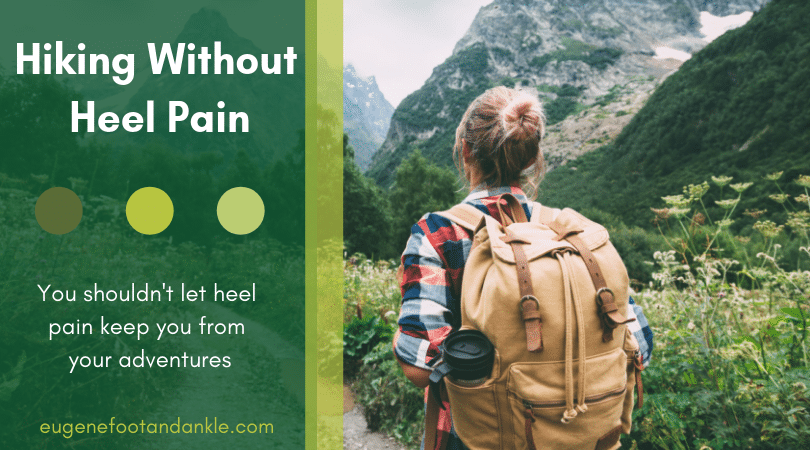Hiking Without Heel Pain
If you are a hiker, then the odds are pretty good you have struggled with heel pain many times over the years. By now, you might have started feeling as though you have tried every trick in the book to get rid of this painful inconvenience, yet nothing seems to work. And, let’s face it – not going on your hiking adventures just isn’t an option!
Here at Eugene Foot and Ankle Health Center, we know that being active is important. But pushing through the pain while you go about your favorite activities is not the best idea either. So what are you to do?
Well, the good news is that there is still hope for curing your “incurable” problem. And we can help you start enjoying your hikes in a way that you never thought possible – without heel pain!
Where is This Pain Coming From?
Yes – your pain is coming from your heel. But what is the cause of it?
There are a variety of reasons why your heels may be giving you grief. However, plantar fasciitis is the most common cause of heel pain. In general, this condition presents as an intense pain in the bottom of the heel whenever you walk, and it’s worse when you first wake up in the morning or when standing after sitting for long periods of time.
Are you thinking this might be the case for you? Let’s see if your symptoms correlate:
- Heel pain. A stabbing pain is often felt in the heel area, particularly underneath the back of your foot.
- Arch inflammation and pain. You may experience a burning and tingling sensation on the bottom of your foot. This can extend to the back of your heel.
- Foot stiffening. You may have difficulty bending your foot back and forth without experiencing considerable pain and discomfort.
Plantar fasciitis typically develops when the wide band of connective tissue that runs across the bottom of the foot becomes inflamed. This usually comes about due to ill-fitting shoes, choice of activities, age, and genetics.
And though this condition normally starts as a subtle pain, giving you no reason to think much of it while you continue to push yourself up those hills, later in the day you are left paying for your lack of concern. So it’s important that you always keep in mind that pain of any kind is never normal – if you experience discomfort, STOP what you are doing and take a seat (and then contact us at the earliest opportunity!).
What Can You Do About Your Heel Pain?
If you are suffering from heel pain, your best course of action is to come visit our Oregon office and let our team of experts determine the root cause of the problem. Treatment will depend on your specific situation, but most methods include:
- Rest. Elevate the affected foot and avoid physical activities for as long as possible until the pain subsides (we know – easier said than done).
- Apply ice to the area in pain. Make sure to use a thin towel to protect your skin.
- Footwear Modifications. Wear shoes that are appropriate for your specific activity, and especially ones that provide adequate cushion and support.
- Custom orthotics will provide the additional cushion and support your arches need in order to be comfortable and pain-free (you can even add them to your hiking boots).
- Anti-Inflammatory Medications. Take nonsteroidal anti-inflammatory medications, like ibuprofen or naproxen in order to reduce pain.
- Activity Modifications. Switching to low-impact activities – even a couple of days a week – like cycling and swimming will help reduce the stress on your heels.
- Foot Exercises. Stretching your calves and doing toe exercises can improve your ligaments and will help make it more flexible.
- Manage Your Weight. Excessive weight puts unnecessary stress on your heels – keep your weight at a healthy level to avoid extra stress on your heels.
Once we have treated your heel pain, you should increase your hiking distance gradually every week – not hiking over 10% more distance/duration than you did the week before. Cross-train and avoid running if you can while your plantar fascia heals. Riding a bike is a particularly good way to stretch tissues and condition your shock-absorbing system.
You should also take 5-10 minutes before and after each hike to stretch your hamstrings and calves.
And, of course, it is important that you seek advice from a medical professional who is trained in foot and ankle problems specifically. So if your heels are causing you pain, let us help you!

Heel Pain Solutions at Eugene Foot and Ankle Health Center
The bottom line is that whenever heel pain comes into the picture, you are looking at some not-so-fun times.
But just because your heels are giving your grief doesn’t mean that you should become a couch potato for the rest of your life – there are simply many beautiful trails to walk through and awesome nature spots to discover.
Come see is here at Eugene Foot and Ankle Health Center and we will perform a thorough evaluation of your feet and ankles in order to determine the root cause of your heel pain.
Depending your diagnosis, we will then create a comprehensive treatment plan tailored to your specific needs. And what’s best – you may not even have to give up hiking at all!
Give us a call at (541) 683-3351 or simply fill out our handy request form online.
Contact Us
Eugene
P: (541) 683-3351
F: (541) 683-6440
Hours:
Monday............ 8:00am - 5:00pm
Tuesday............ 8:00am - 5:00pm
Wednesday............ 8:00am - 5:00pm
Thursday............ 8:00am - 5:00pm
Friday............ 8:00am - 4:00pm (Only available on phones)
Closed for lunch from 12pm - 1pm and closed until 1:30pm on Tuesdays
© Copyright 2024 Eugene Foot and Ankle. All Rights Reserved. | Privacy Policy.

